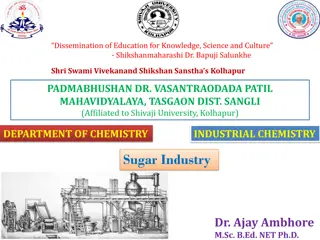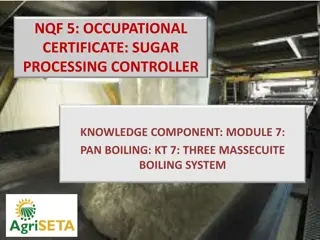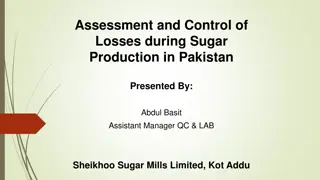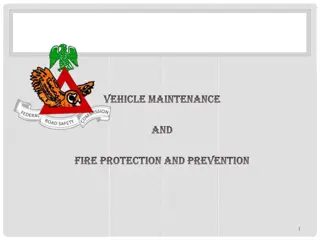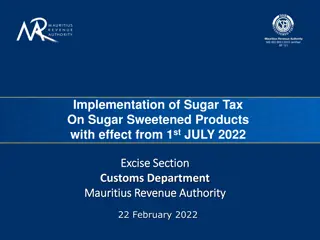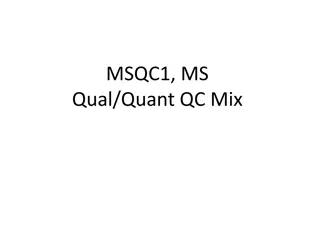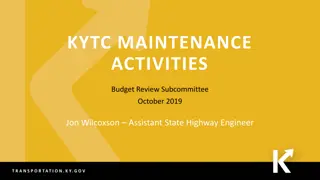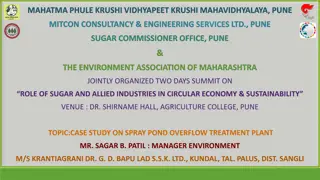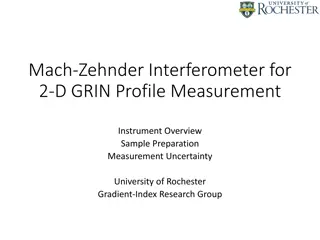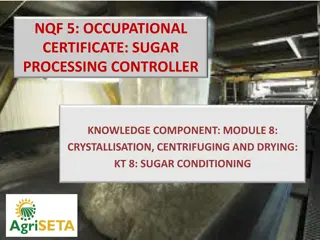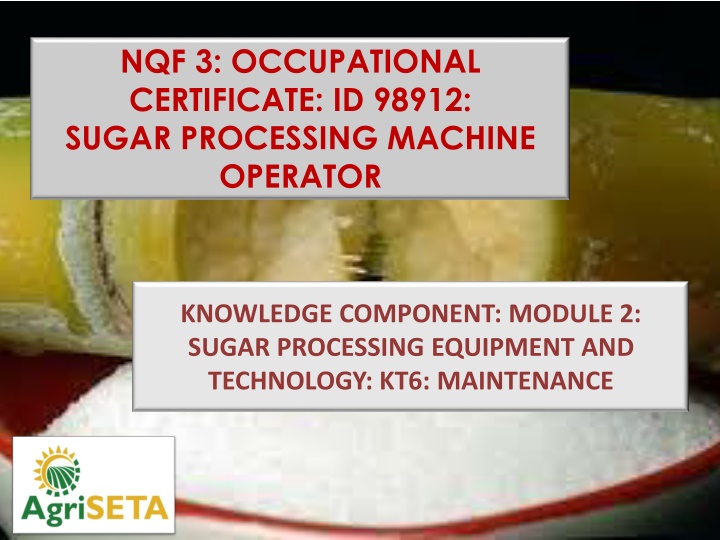
Preventative Maintenance in Sugar Processing Equipment and Technology
"Learn about the importance of preventive maintenance in sugar processing machines, including lubrication, inspection, and different types of maintenance strategies such as time-based, work-based, opportunity-based, and condition-based. Discover how to prevent breakdowns and ensure smooth operations in sugar processing facilities."
Download Presentation

Please find below an Image/Link to download the presentation.
The content on the website is provided AS IS for your information and personal use only. It may not be sold, licensed, or shared on other websites without obtaining consent from the author. If you encounter any issues during the download, it is possible that the publisher has removed the file from their server.
You are allowed to download the files provided on this website for personal or commercial use, subject to the condition that they are used lawfully. All files are the property of their respective owners.
The content on the website is provided AS IS for your information and personal use only. It may not be sold, licensed, or shared on other websites without obtaining consent from the author.
E N D
Presentation Transcript
NQF 3: OCCUPATIONAL CERTIFICATE: ID 98912: SUGAR PROCESSING MACHINE OPERATOR KNOWLEDGE COMPONENT: MODULE 2: SUGAR PROCESSING EQUIPMENT AND TECHNOLOGY: KT6: MAINTENANCE
Preventative Maintenance Preventive maintenance consists of routine actions taken in a planned manner to prevent breakdowns. Lubrication and inspection are the two constituents of preventive maintenance. Lubrication ensures long and safe working of the equipment without mishaps.
Preventative Maintenance Inspection facilitates detection of faults in the equipment so that repairs and replacements may be undertaken before the faults assume the proportion and shape of a breakdown. The preventive maintenance function is sub- divided as Preventive maintenance of production departments and Preventive maintenance of plant services.
Preventative Maintenance (cont.) Preventive maintenance of production departments includes anticipatory inspection and servicing of equipment besides routine maintenance. The other important plant services requiring preventive maintenance are: Buildings Power plant Material handling equipment Transport vehicles Water supply Waste disposal systems Store-rooms Tool-rooms Offices Firefighting facilities
Preventative Maintenance (cont.) Types of Prventative maintenance include: Time-based preventive maintenance: This refers to conducting maintenance at regular intervals, e.g., every two months, etc. It is easy to monitor time and this form is used when deterioration is likely to be time rather than usage- dependent, or when usage cannot easily be measured. Work-based preventive maintenance: Maintenance performed after a set number of operating hours of volume of work produced, e.g., every 40,000 photocopies in a xerox machine, etc. Usage can be more difficult than time to monitor and some form of auto-counting of output should be used, if possible.
Preventative Maintenance (cont.) Types of Prventative maintenance include (cont.): Opportunity-based preventive maintenance: Repair or replacement takes place when the equipment or system is devoid of work, e.g., during a holiday. Condition-based preventive maintenance: This method often relies on planned inspection to reveal when maintenance is prudent, e.g., replacement of a brake pad when it has worn to 2mm thickness. This is dependent on monitoring the equipment condition which can be difficult, and impractical if a time-consuming strip-down precedes any examination or inspection. These various forms of maintenance often operate together, overlap or coincide.
Preventative Maintenance (cont.) Synonyms for Preventative Maintenance include: Running Maintenance: In running maintenance the preventive maintenance work is carried out while the equipment is in service. Shutdown Maintenance: In shutdown maintenance the preventive maintenance work is carried out when the equipment is out of service. Servicing: In servicing, the minor activities like cleaning, lubrication, etc., are carried out at planned intervals.
Preventative Maintenance (cont.) Synonyms for Preventative Maintenance include (cont.): Scheduled Maintenance: Scheduled maintenance system provides for inspection, overhauling, lubrication, and servicing of certain machines at predetermined dates. For example, overhauling of machines, cleaning of tanks and white washing of buildings are normally done in this manner. This type of maintenance is, therefore, practiced to a certain extent, even in those companies where breakdown maintenance is otherwise a rule.
Preventative Maintenance (cont.) Planned Maintenance: Represents advancement over the above mentioned types of maintenance practices. Visualizes the work contained in a future job, Determines the best method to be adopted and skills required for its execution, Estimates the time, material and costs involved in assigned jobs and Programmes that work to specific time periods on the basis of priority. Planned maintenance also provides for a system of feedback of information for necessary changes in the original plan.
Preventative Maintenance (cont.) Predictive Maintenance: A new type of preventive maintenance known as predictive maintenance is becoming popular. It involves the use of sensitive instruments to predict trouble. Such maintenance helps in determining the need for and time of overhauling.
Preventative Maintenance (cont.) To develop a preventative maintenance management plan the following elements should be considered: An inventory of all the plant and equipment that need to be maintained. Categorization of equipment to assess the relative importance and thereby determine the equipment requiring preventive maintenance A well-designed inspection system. A good lubrication system i.e., regular cleaning, greasing and oiling of the moving parts
Preventative Maintenance (cont.) To develop a preventative maintenance management plan the following elements should be considered (cont.): Maintenance of adequate records and analysis of the same. Planning of maintenance work. Control of maintenance stores and spares. Organization for preventive maintenance work. Replacement of worn-out parts before they fail to operate. Provision of stand-by machines for critical equipment.
Objectives of Preventative Maintenance To make plant equipment and machines always available and ready for use. To minimize unanticipated production interruptions To maintain the value of the equipment and machinery To reduce the work content of maintenance jobs. To ensure safety of life and limbs of the workmen.


